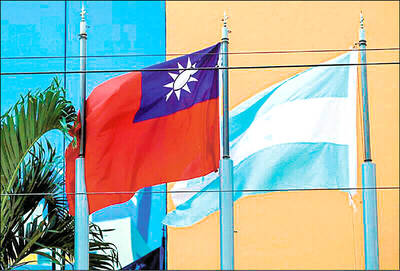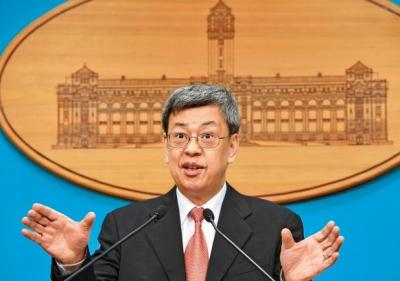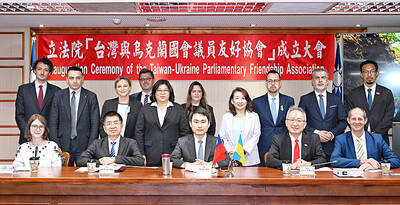A panel of defense experts on Thursday called for an Indo-Pacific initiative to combat disinformation, including efforts directed by Beijing.
Speaking at the Asia-Pacific Security Dialogue, a virtual conference hosted by the Ministry of Foreign Affairs, Lieutenant General Liu Te-chin (劉得金) said that disinformation is in China’s arsenal of “fourth-generation warfare” tools to use against Taiwan.
Fourth-generation warfare — a term used by US defense analysts in the 1980s — describes methods of conflict that blur the lines between war and politics.
China’s application of the idea includes demoralizing propaganda, Web-based disinformation, confrontations at sea and in the air, and manufactured disputes, said Liu, who is inspector-general of the Ministry of National Defense.
Steadily escalating “gray zone” conflict is aimed at diminishing trust in Taiwan’s government, he said.
Taiwan has improved its multiagency coordination, civil-military cooperation, information verification and partnerships with foreign states, he said.
The military has prepared mechanisms for rapid response and strategic communication, he added.
Taiwan has unique insight into China’s disinformation techniques that other countries lack, said Bonny Lin, director of the China Power Project at the Center for Strategic and International Studies.
Malicious influence campaigns are being directed against countries around the world, and governments could benefit from Taiwan’s wisdom and experience, Lin said.
The international community must join forces to honestly discuss the problem of disinformation and educate people to counter its effects, she said.
The fast-growing economies and fragile democracies of the Indo-Pacific region are vulnerable to online foreign meddling, said Jacob Wallis, head of information operations and disinformation at the Australian Strategic Policy Institute.
Countries in the region should create a forum or platform to defend their societies against targeted disinformation campaigns, Wallis said.
Such a forum should be open to experts working in academia and the private sector, not just government officials, he said, adding that it is needed to make governments more agile in their response to threats.
In related news, a military source yesterday said that two Chinese People’s Liberation Army vessels were identified off Taiwan’s east coast over the past two days.
A Chinese missile frigate was spotted 40 nautical miles (74km) off Hualien County at about 3am on Thursday, presumably heading south into the Bashi Channel, the source said.
Another frigate was detected about 24 hours later about 116 nautical miles off Green Island (綠島), the source added.
The second frigate sailed out of radar range at about noon yesterday, the source said, without saying which direction it was headed.
It was unclear why the ships were navigating so close to Taiwan, the source added.
Patrol ships from the 131st Fleet in Keelung were deployed on both occasions to monitor the frigates, the source said.
Ministry of National Defense spokesman Major General Shih Shun-wen (史順文) declined to comment on the report, saying only that the military constantly monitors military activities near Taiwan.
Additional reporting by CNA

Several Chinese Nationalist Party (KMT) officials including Chairman Eric Chu (朱立倫) are to be summoned for questioning and then transferred to prosecutors for holding an illegal assembly in Taipei last night, the Taipei Police said today. Chu and two others hosted an illegal assembly and are to be requested to explain their actions, the Taipei City Police Department's Zhongzheng (中正) First Precinct said, referring to a protest held after Huang Lu Chin-ju (黃呂錦茹), KMT Taipei's chapter director, and several other KMT staffers were questioned for alleged signature forgery in recall petitions against Democratic Progressive Party (DPP) legislators. Taipei prosecutors had filed

Taiwan would welcome the return of Honduras as a diplomatic ally if its next president decides to make such a move, Minister of Foreign Affairs Lin Chia-lung (林佳龍) said yesterday. “Of course, we would welcome Honduras if they want to restore diplomatic ties with Taiwan after their elections,” Lin said at a meeting of the legislature’s Foreign Affairs and National Defense Committee, when asked to comment on statements made by two of the three Honduran presidential candidates during the presidential campaign in the Central American country. Taiwan is paying close attention to the region as a whole in the wake of a

President William Lai (賴清德) has appointed former vice president Chen Chien-jen (陳建仁) to attend the late Pope Francis’ funeral at the Vatican City on Saturday on his behalf, the Ministry of Foreign Affairs said today. The Holy See announced Francis’ funeral would take place on Saturday at 10am in St Peter’s Square. The ministry expressed condolences over Francis’ passing and said that Chen would represent Taiwan at the funeral and offer condolences in person. Taiwan and the Vatican have a long-standing and close diplomatic relationship, the ministry said. Both sides agreed to have Chen represent Taiwan at the funeral, given his Catholic identity and

Lawmakers from the Democratic Progressive Party (DPP) yesterday established a friendship group with their counterparts in Ukraine to promote parliamentary exchanges between the two countries. A ceremony in Taipei for the Taiwan-Ukraine Parliamentary Friendship Association, initiated by DPP Legislator Chen Kuan-ting (陳冠廷), was attended by lawmakers and officials, including Deputy Minister of Foreign Affairs Francois Wu (吳志中) and European Economic and Trade Office in Taiwan Director Lutz Gullner. The increasingly dire situation in Ukraine is a global concern, and Taiwan cannot turn its back when the latter is in need of help, as the two countries share many common values and interests,